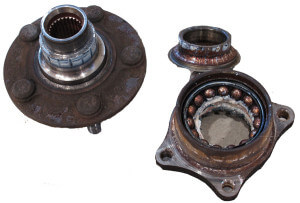Do I need new wheel bearings
Diagnose a wheel bearing
About once a week in auto forums I seek people ask “Do I need new wheel bearing?” The real question they’re asking is, “How do I know if I need new wheel bearings?” Let me walk you through the tests to see if your symptoms match those of a bad wheel bearing.
What makes a wheel bearing fail
Seal damage is #1 reason for wheel bearing failure. Once the seal is damaged, water and dirt get in. That washes out the grease and wears out the bearing.
Water and wheel bearing grease don’t mix well. In fact,

This bearing was making noise for a LONG time and the owner ignored it
when water enters a bearing and is mixed with the grease and heated from bearing rotation the grease and water form sludge. Sludge doesn’t flow as well as grease and certainly doesn’t lubricate as well. Dirt, well, what can I say about dirt. It simply grinds up the balls and rollers and pits the race, causing the bearing to run rough and make noise.
Improper torque is another major cause of wheel bearing failure
Whether your car has tapered roller bearings, a pressed in sealed bearing, or a integral hub/bearing unit, each requires the proper torque for long life. If you’ve repacked the bearings, replaced an axle or CV joint, it’s critical that you use a torque wrench to tighten the bearing/axle. Too little torque allows the bearing to move slightly in turns causing uneven wear. Too much torque causes stress in the race.
Adding custom wheels, wheel spacers and wheel offsets can wear out your wheel bearings
Sure they look cool. But your car’s geometry wasn’t designed for them.

Change the geometry of your suspension and you change the load factors on your wheel bearings
If you install custom wheels, wheel spacers, wheel offset, and sometimes even larger tires, you change the center of the load on the bearing. You may look cool, but you’re destroying your bearings. Nuf said.
Impact damages wheel bearings
Hit a curb and you can damage your wheel bearings. Use an impact wrench to install or remove an axle nut and you can damage a wheel bearing. You think they’re really tough. They’re not. The plating is brittle and shock can break it. Once that plating rolls around in the race, it wears the bearing can causes noise.
Symptoms of a bad wheel bearing
1) Roaring noise at higher speeds. The noise changes in character or stops when you change lanes or turn.
2) Popping noise when turning. This can also be caused by a worn CV joint, so don’t jump to conclusions on this.
3) Clicking noise. This can also be caused by a worn CV joint, so don’t jump to conclusions on this.
4) Grinding. By the time your bearing starts grinding, it’s ready to take a powder. Shame on you for ignoring all the warning signs up until now.
5) Loose steering. A wheel bearing that’s worn will have play and that causes loose steering.
How do I know if I have need new wheel bearings
1) Raise the vehicle and check each wheel. Place your hands on the tire in the 12:00 and 6:00 positions and try to move the top and bottom of the tire in and out. There should be no more than .001-.004” of play. Then move your hands to the 3:00 and 9:00 positions and repeat the test. Once again, there should be no more than .001-.004” of play.
2). While driving and hearing the noise, change lanes and make a series of turns. A worn bearing will make more noise when a load is placed on it. However, the noise will come from the opposite side: You’ll hear noise from the right side bearing when making a left hand turn.
3) At a shop, have the technician raise the vehicle and put the vehicle in drive while on the lift. Then use a stethoscope touched to the knuckle, spring, and control arm. A worn bearing will reverberate through those components.
©, 2015 Rick Muscoplat
Posted on by Rick Muscoplat